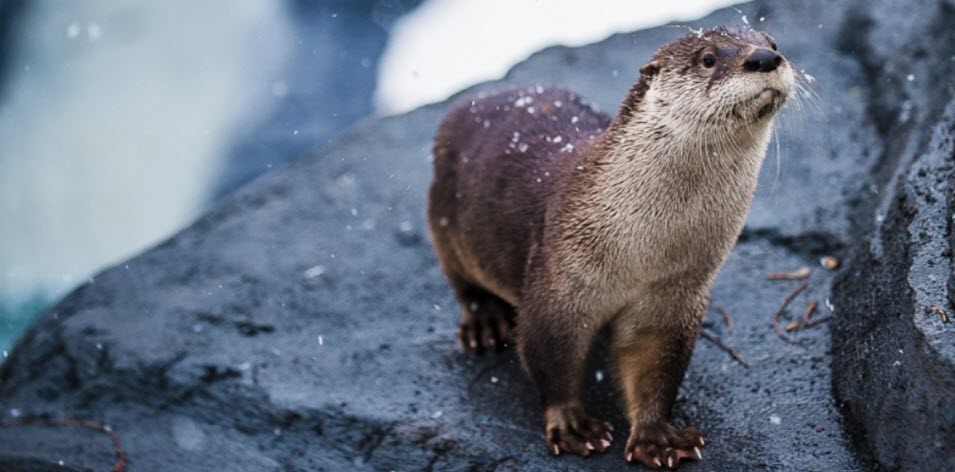The Ecomuseum Zoo (Zoo Ecomuseum) in a 28 acre zoological park located on the Island of Montreal and operated by the Saint-Lawrence Valley Natural History Society
Over a hundred different animal species live in this zoological park, which focuses on animals native to the Saint Lawrence Valley of south-western Quebec.
The Ecomuseum Zoo is accredited by the Canadian Association of Zoos and Aquariums (CAZA).

Animals
Here are a few examples of animals that you may encounter during your visit:
Mammals
- American marten
- American porcupine
- Arctic fox
- Black bear
- Coyote
- Fisher (Pekania pennanti), a small, carnivorous mammal native to North America.
- Gray wolf
- Lynx
- Racoon
- Red fox
- River otter
- White-tailed deer
- Woodland caribou
Birds
- American black duck
- American kestrel
- Bald eagle
- Barn owl
- Barred owl
- Canada goose
- Common goldeneye
- Common raven
- Eastern screetch-owl
- Golden eagle
- Great-horned owl
- Great winged teal
- Hooded merganser
- Night heron
- Northern pintail
- Red-tailed hawk
- Snowy owl
- Turkey vulture
- Wild turkey
Reptiles & Amphibians
- Blue-spotted salamander
- Common mudpuppy
- Northern leopard frog
- Spring peeper
- Yellow-spotted salamander
- Black rat snake
- Blanding’s turtle
- Common map turtle
- Common snapping turtle
- Eastern musk turtle
- Milk snake
- Northern ribbon snake
- Smooth green snake
- Wood turtle
Background
The Santi Lawrence Valley Natural History Society was opened by Dr. John Roger Bider in 1981 to educate children about the environment.
The Ecomuseum Zoo is located on land that used to be wetland, but was partially filled out with garbage in the 1960s.
The ecomuseum was opened in 1988 and the first education programs on the site were launched the following year.
The first building – a house for administration and education – was built here in 1992.
In the early years, the ecomuseum was only open to the public during the warm season. Since 1996, it has also been open during the cold season.
Do you want to be a part of the Amphibian Population Monitory Program?
Quebec is home to 11 species of frog and toad, and the Ecomuseum Zoo has been mandated by the provincial government to coordinate a long-term project focused on monitoring the populations of frogs, tree frogs and toads.
Do you want to help out with the Amphibian Population Monitory Program? To keep on eye, or rather an ear, on the populations throughout Quebec, frog call routes have been established throughout the province. Each route is 8 km long and needs to be visited twice each evening during the spring months by volunteers listening for frog calls. There are 10 listening stations at each route, spaced 800 meters from each other. If you are a volunteer, you will spend 3 minutes at each station, listening to frog calls and writing down each species you can hear.
As a volunteer, you will not be expected to be out here every night listening to frogs. In order to sign up as a volunteer, being willing an able to volunteer two (2) evenings in the springtime is enough, although you are of course welcome to sign up for more evenings if you want to.
For more information, contact the Ecomuseum Zoo.
Where is the Ecomuseum Zoo?
The Ecomuseum Zoo is a 28 acre (11.3 hectares) zoological park in Sainte-Anne-de-Bellevue, on the western tip of the Island of Montreal.
Address
21125, Chemin Ste-Marie
Ste-Anne-de-Bellevue, QC, H9X 3Y7
Phone number
514-457-9449
Getting to Saint-Anne-de-Bellevue
Sainte-Anne-de-Bellevue is an on-island suburb within the Greater Montreal area. It is situated on the western tip of the Island of Montreal.
By road
Sainte-Anne-de-Bellevue is traversed by Autoroute 40 (the Trans-Canada Highway) and Autoroute 20, which crosses the Ottawa River over the Galipeault Bridge linking it to Île Perrot.
It is serviced by the bus network of the Société de transport de Montréal (http://www.stm.info/en).
By railway
The Sainte-Anne-de-Bellevue commuter train station is a part of the Vaudreuil-Hudson Line.
